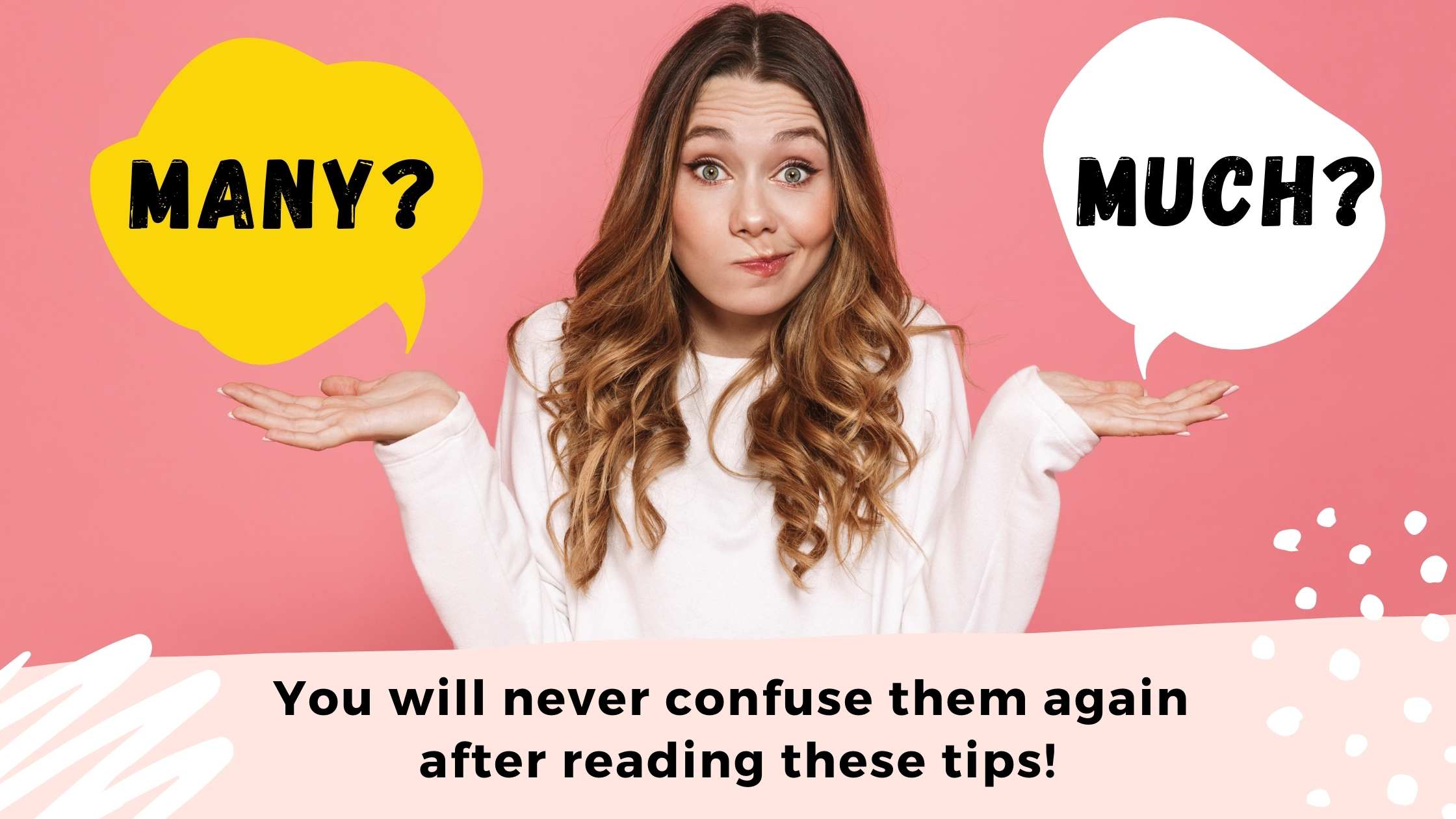Many, Much, or A Lot? Learn These English Quantifiers So You Never Confuse Them Again!
We ask questions every day. Some questions may be related to weather, some may be about somebody’s family, and some are related to quantity. Whenever we talk about amounts, we will use what we call quantifiers. There are several quantifiers we can use, such as some, any, no, a few, a little….today we will go over many, much, a lot, and a lot of. You will understand the use of many and much, as well as practice with many, much, and a lot of exercises.
English quantifiers and how to use them
As we mentioned above, quantifiers are words that we use to talk about quantities. We put them before a noun (like animals, objects, people, places, etc.) to mention the amount of that particular thing. Some quantifiers are used to express large amounts (much, many, all, etc.), some are used to express small amounts (little, few, etc.) and some are used to say we don’t know exactly the amount we are talking about (some, any).
These are some common quantifiers: all, every, almost all, almost every, most, many, much, a lot, a lot of, some, several, a few, few, a little, little, a couple, almost no, no, each, any, a bit, enough, plenty. Take a look at some examples:
- I need to sell several things before moving into my new apartment.
- Susan has all of the books J.K Rowling has ever written. She is a big fan of hers!
- I have enough money to travel to London next week.
Try using English quantifiers in this quiz below.
This article focuses on learning how to use many, much, a lot, and a lot of. But, before going into that, we need to understand the difference between countable and uncountable nouns.
Countable and uncountable nouns: understand the difference
The definition of countable and uncountable nouns can be tricky. Watch this video to learn how to tell the difference.
In order to help you understand the difference between them, let’s take a look at the explanation below.
Countable nouns
Countable nouns are nouns that we can count using numbers.
In order to ask a question about the amount of countable nouns, you will use the question How many…?
You will also use many to create affirmative and negative sentences, such as:
- I have many dogs at home.
- My sister doesn’t read many books.
Also, countable nouns are found in a singular and a plural form.
Examples of countable nouns are: book(s), girl(s), phone(s), fork/forks, bed/beds, cat/cats, sofa/sofas.
Uncountable nouns
Uncountable nouns are nouns that we cannot count using numbers.
Examples of uncountable nouns are money, time, tea, sand, electricity, love, knowledge, evidence, rice.
We use much to talk about the amount of uncountable nouns. We can ask questions about uncountable nouns by saying How much…?
- How much money do you have?
- How much rice do you eat a week?
If you are thinking to yourself: “Well, I can count rice, can’t I?”
Yes, you can. You can say you ate 2 spoons of rice or that you usually make 2 cups of rice for dinner. Note that in both of these examples we use a container to talk about quantity. These containers (spoon and cup) are countable, but the rice itself is not. Therefore, we can say:
- I ate too many spoons of rice today.
- Angela will have dinner with us today. I will make many more cups of rice then.
But we will say:
- I ate too much rice today!
- I think you need to make much more rice, honey. Angela is coming for dinner!
Money is another noun English learners often have questions about. Is it countable or uncountable? A common question is:
“How come ‘money’ is uncountable if I can count cash?”
Well, you are right. We can count cash. However, we count bills (or notes, in British English) and coins. Therefore, it is possible to say:
- I have many 5-dollar bills in my wallet.
- Do you need coins? I have too many of them at home.
If you are talking about money in general, you would use much though. Let’s take a look at some examples:
- Sorry, I can’t go out tonight. I don’t have much money.
- Bill Gates has so much money.

Many
We use many to talk about a large number of things. Many is used before plural and countable nouns, such as books, people, cats, flowers, bottles, etc. It is possible to use many in affirmative sentences, negative sentences, and questions. Let’s take a look at examples of sentences using many.
Examples of sentences with ‘many’
Affirmative phrases
Laura has many friends.
They traveled to many countries last summer.
We will buy many clothes at the mall tomorrow.
Negative phrases
Laura doesn’t like many fruits. She only eats bananas.
They didn’t like many cities in France. Paris was their least favorite.
We didn’t find many formal dresses at that store.
Questions
How many siblings does Laura have?
Do they have many suitcases?
How many people did you invite to your party?
English intensifiers: so, too, more
Intensifiers are types of words that show something is emphasized. Whenever you need to emphasize the word ‘many’, you can use the following combinations:
So + many
We use so many to refer to a large number of something without specifying exactly the quantity of the object in question.
Remember to use so many with countables nouns only. Take a look at some examples.
- I have so many clothes I don’t wear anymore.
- She has so many friends!
- There are so many animals in South Africa.
Too + many
We use too many whenever we want to refer to something that is more than necessary. The use of too many implies a negative feeling.
For example, after a visit to the Eiffel Tower in Paris you can say:
“I loved it but there were too many tourists there! I couldn’t even move”.

What we can understand from the sentence is that even though the person loved visiting the tower, he/she didn’t enjoy the number of tourists that were there, which made the experience a bit negative.
Here are a few more examples:
- He put too many strawberries in the cake. It’s soggy!
- I have too many purses in my closet. Should I donate some?
- I bought too many cupcakes. Please take some home!
Many + more
We use the word many to emphasize the word more, which means a greater or additional amount of something. We can say many more or much more and it is simple to decide which one we use – it all depends on the noun we are talking about. For instance:
- They need many more volunteers in order to hit their goal.
We use many more because volunteers is a countable noun. Countable nouns need to be used with ‘many’.
- We are going to stay here at the mall for a while…She wants to buy many more clothes.
Clothes is a countable noun, so we use many to modify the words ‘more clothes’.
Much
We use much to talk about a large number of things. Much is used before uncountable nouns, such as money, time, feelings (love, hate, etc), sand, rice, etc. Much is commonly used in negative sentences and questions. However, much is not common in affirmative sentences.
Let’s take a look at examples of sentences using much.
Examples of sentences with ‘much’
Negative phrases
Adam doesn’t have much time to study.
I don’t know much about basketball.
She won’t spend much money on her wedding dress.
Questions
How much milk do you drink in the morning?
Does he have much money in the bank?
How much does this computer cost?
English intensifiers: so, too, more
Intensifiers are types of words that show something is emphasized. Whenever you need to emphasize the word much, you can use the following combinations:
So + much
We use so much to refer to a large amount of something that is uncountable, like ‘love’, ‘water’, or money. Remember to use so much with uncountables nouns only. Take a look at some examples.
- He drinks so much water.
- She has so much money!
- There is so much time left.
Too + much
Just like too many, we use too much to refer to something that is more than necessary. The use of too much implies a negative feeling and it is always used with uncountable nouns.
- He spent too much money on his new car.
- She drinks too much soda.
- I have been spending too much time scrolling through social media lately.

Much + more
We use the word much to emphasize the word more, which means “a greater or additional amount of something.“
We can say many more or much more and it is simple to decide which one we use — it all depends on the noun we are talking about. In the examples below, we are using ‘much more’ with the uncountable nouns water, attention, and food.
- We need to buy much more water before going camping.
- Adam needs much more attention than his sister.
- The dog wants much more food.
A lot, a lot of, lots of
Both a lot of and lots of have the same meaning. We use them before countable and uncountable nouns.
Examples with countable nouns
- There are a lot of books in the library. (in this case, a lot of = many)
- Lots of people like Mary. She is very popular at school. (in this case, lots of = many)
Examples with uncountable nouns
- She has a lot of money to give away. (in this case, a lot of = much)
- Mike needs lots of help with the project. (in this case, lots of = much)
Meanwhile, a lot or lots of is the same as very much or very often. It is considered an adverb, so we never place it before the noun. We usually use it at the end of a sentence. Let’s take a look at some examples, shall we?
- She has a lot of time.
- My cat is eating a lot of food. Should I take him to the vet?
- My grandpa wants a lot of space for his new hobby. He is building model trains.
Practice using English quantifiers with these exercises
We know these words can be confusing. Don’t panic! The best way to understand the difference between them is by practicing. You can join us at our Free Conversation Club. How does that sound? In the meantime, we hope this blog post will help you understand how to use English quantifiers like many, much, and a lot. Don’t forget to do the exercises to practice using these tricky quantifiers!


